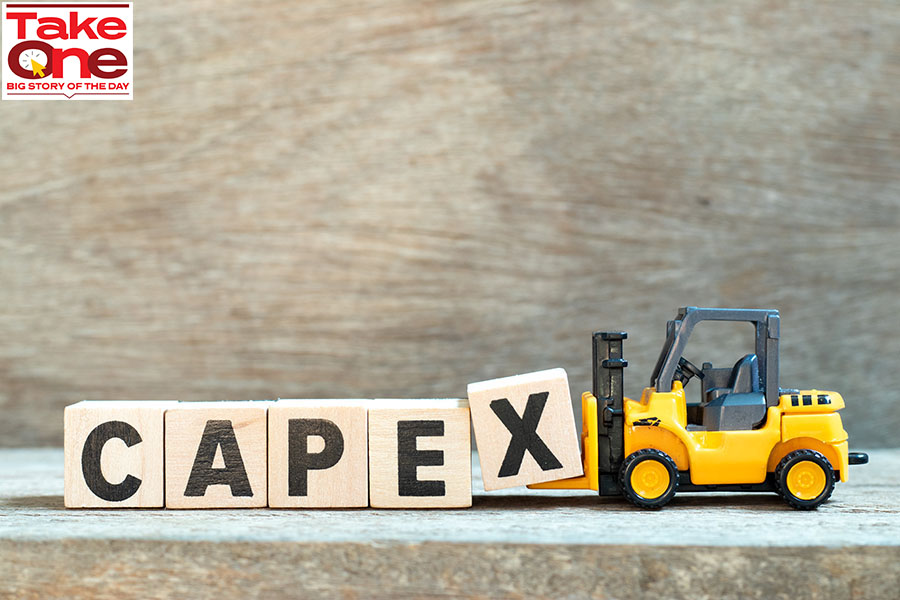
Budget 2024: Expect moderation in pace of government capex growth
The government has done the heavy lifting of spending on infrastructure projects in recent years. It could well moderate the pace of growth for capex in this budget, while focusing on social infrastructure and welfare projects in the election year
 As per Crisil’s research estimates, the growth in capital expenditure is likely to moderate to around 10 to 15 percent in fiscal 2025 since the government is likely to focus on and improve its fiscal deficit profile
Image: Shutterstock
As per Crisil’s research estimates, the growth in capital expenditure is likely to moderate to around 10 to 15 percent in fiscal 2025 since the government is likely to focus on and improve its fiscal deficit profile
Image: Shutterstock
Much of the euphoria surrounding India’s projected pace of growth in recent years and the future, has been based on the government’s strong push for capital expenditure (capex), in a bid to make India a $5 trillion economy by 2025. This target, experts have said, appears to be stretched. But there is no doubting that a greater push in government and private capex will help boost productive capacity and creating opportunities for job creation.
The government will present the interim budget on February 1, and though large scale policy announcements are not expected, it will provide an estimate of its expenditure, revenue, fiscal deficit and financial performance and projections for the upcoming financial year. The more detailed budgetary announcements for FY25 will emerge post elections, when the new government takes charge.
Govt capex growth moderation
Experts we spoke to indicate that the ruling government will be constrained to keep pushing for a higher pace of government capex growth in the coming financial year. “In the past few years, the central government had undertaken robust capital expenditure with a sharp focus on infrastructure development in order to propel the economy. Against that backdrop, the growth in the central government’s budgetary allocation for capital expenditure is likely to see some moderation in fiscal 2025,” says Aniket Dani, director-research, Crisil Market Intelligence & Analytics.As per Crisil’s research estimates, “the growth in capital expenditure is likely to moderate to around 10 to 15 percent in fiscal 2025 since the government is likely to focus on and improve its fiscal deficit profile,” Dani tells Forbes India. Nonetheless, owing to the high base, the absolute quantum of capital expenditure is still expected to be high, he says.
Economists with global investment bank Goldman Sachs have also indicated that although the focus on capex will continue, it will be ‘at a slower pace” than what was seen in the last few years.
HDFC Bank’s Chief Economist Abheek Barua says that the ability of the government [to aggressively push for capex] might be constrained by the need for fiscal consolidation. Barua also expects a moderation in spending towards capex for the upcoming budget, but says the government will be focussed on “quasi- social infrastructure projects such as drinking water, sanitation, electrification and development of affordable housing.
“It might now be important to look at some areas of revenue spending which are developmental in nature. This will mean more allocations towards nutrition, health care, women empowerment and allocation to the Ayushman Bharat Yojana,” Barua tells Forbes India.
A further allocation towards the PM-Kisan Samman Nidhi, which provides direct income support to farmer families having cultivable land up to two hectares, will be a welcome step. Barua says the government may want to focus more on the mid-day meals, as part of the Poshan 2.0 programme, detailing composition and adding proteins to the meals, to boost child nutrition and development.
Also read: Budget 2024: The long road to fiscal consolidation
Sustained focus on railways, roads
Crisil’s Dani says the thrust towards infrastructure development is likely to continue in fiscal 2025 as well with areas such as transportation and logistical connectivity to retain their importance in terms of capital expenditure.“The Ministry of Road Transport & Highways (MoRTH) and Ministry of Railways (MoR) are likely to do the heavy lifting in terms of infrastructure capital expenditure. These ministries are likely to account for a significantly high chunk of government’s capital expenditure on infrastructure,” Dani says.
“The budgetary allocation for MoRTH is expected to increase by 10 to 15 percent in this fiscal year's budget. This is on account of higher construction leading to higher capex requirement. Almost the entire support is likely to be provided through the gross budgetary support (GBS) medium with minimal reliance on Internal and Extra Budgetary Resources (IEBR),” Dani says.
As a result, National Highways Authority of India (NHAI), which faces an uphill task of servicing its total debt burden of Rs3.4 lakh crore as of 2023, can keep its market borrowings negligible. “Furthermore, due to the lack of market borrowings, the reliance on monetisation modes such as TOT and InvITs is likely to remain high for MoRTH,” Dani says.
Simultaneously, the FY25 budget is expected to allocate increased capital to the railway sector, aligning with the government's emphasis on revitalising railway assets and infrastructure development. Initiatives like the introduction of Vande Bharat trains, station redevelopment, and new track laying will play a crucial role in railway capital expenditure.
“The government's commitment to safety improvements and asset replacement, including tracks, bridges, and locomotives, remains a priority. Additionally, ambitious projects like the bullet train and the proposed India-Middle East-Europe economic corridor are also poised to attract significant capital investment,” Dani says.
Dani adds that the rise in expenditure on welfare schemes is also likely to support rural incomes and help in recovery in the rural economy, which has so far lagged the recovery in urban economy post the covid-19 pandemic.
The critical factor to decide on expenditure will depend on the government’s commitment to fiscal consolidation. The government is well aware – thanks to Prime Minister Narendra Modi’s experience as a state chief minister earlier -- of how budget overruns can impact the ability of the state to spend.
Post Your Comment


















